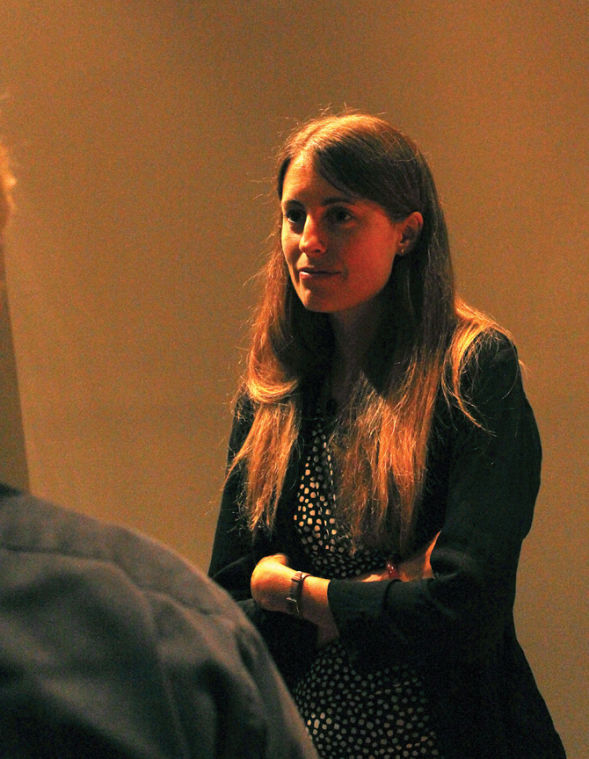Italian cinema a matter of style
Dr. Monica Seger, assistant professor of Italian at the University of Oklahoma, answers audience questions after the Italy theme semester seminar, Neorealism: Material Conditions, Ideological Motivations and Lasting Effects on Monday in Corley auditorium.
A century of progress in Italian cinema started with one of the first Italian films, The Taking of Rome, directed by innovator Fioleteo Albertini in 1905.
That tidbit was one of facts presented by Monica Seger, assistant professor of Italian at the University of Oklahoma, in her talk “Italian Film from Cabiria to Caeser Must Die,” on Sept. 9.
She said film was initially considered entertainment for the lower classes, but soon it was embraced as a more elevated art form.
Seger showcased advancement of technologies with clips from Cabiria (1914), the first full length epic more than two hours long.
Following a period of decline in the 1920s, new developments of sound and camera movement in the early 1930s revitalized the industry.
Benito Mussolini formed the government bureau Centro Sperimental di Cinematografia, in Rome, in 1935. It was an effort of a Fascist government to control the output of the film industry during his time as prime minister, Seger said.
Mussolini embraced the film industry as a means to pacify the citizenry. He encouraged the types of films that came to be called “white telephone films.” These films were light and fluffy. He believed that keeping people entertained would keep them passive.
“At that time the white telephone signified social status,” Seger said. “Having a white telephone in your home was an indicator of a certain level of wealth.”
The style of neorealist filmmaking was particularly significant to the development of the medium in Italy and was the topic of a separate presentation in which Seger described and defined its importance.
The era of neorealist films in Italy began immediately following the end of World War II and lasted until the early 1950s.
The harsh realities in the aftermath and economic recovery from the war did not lend itself to lighthearted entertainment.
Filmmakers began to produce true to life works shot with natural light and somber techniques, using non-professional actors to capture the reality of post-war life.
The late 1950s brought a return of comedy to films as economic prosperity was returning to the country.
It was during this time that Sophia Loren and Gina Lollobrigida attained international recognition.
The mid-1960s brought the era of what became known as spaghetti westerns. One of the earliest directors of that genre was Sergio Leone, who directed a young Clint Eastwood in the Dollar Trilogy.
The auteurs style of filmmaking that depicted the director’s vision and spanned many decades and genres followed. The works of Italian film directors Federico Fellini and Roberto Benigni fall into this category.
A decade of award winning films in the 1990’s has established a new respectability for the Italian cinema. As of 2013, 13 Italian films have been honored at the Academy Awards as the Best Foreign Language Film.
For those who were unable to attend this or any of the scheduled lectures and presentations of the themed semester, KGCS TV-22 has committed to record and feature each event. The three events that feature Dr. Monica Seger will air at 8 p.m. on Sunday, Sept. 15; Monday, Sept. 16; and Wednesday, Sept. 18.
Your donation will support the student journalists of Missouri Southern State University. Your contribution will allow us to purchase equipment and cover our annual website hosting costs.




























